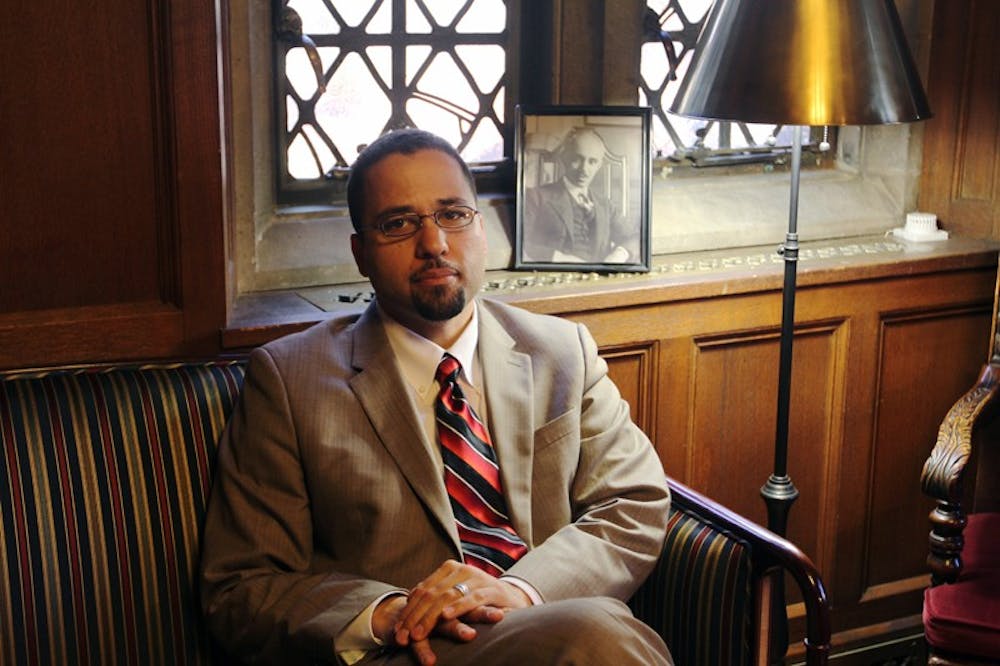The Rev. Luke Powery came to Duke at a momentous time. His first year coincides with the 50th anniversary of Duke’s first black undergraduates, and he is the Chapel’s first black dean.
Powery’s approach to balancing leadership and race offers a surprising contrast to the way other black leaders have cast themselves—President Barack Obama being the most notable example. Obama steadfastly avoided talking about race or identifying himself as a “black candidate” during both of his presidential campaigns. He acknowledged the legacy of race in our country but downplayed his own ethnic background in hopes of post-racial unity. I wondered if Powery would share that perspective. I asked him if he feels a difference between being the first black Chapel dean and simply being the sixth Chapel dean. He said that he did.
“There’s more responsibility because of the historic moment—not just being the first, but the convergence with the celebration of the 50th anniversary,” he said, acknowledging that his work at the Chapel could “pave the way for future generations.” But alongside that sense of responsibility comes “a sense of humility.” Powery often remembers the many people who paved the way for this historic appointment, particularly individuals from Duke’s unique history.
“There’s a lot of history interwoven in Duke Chapel in terms of race and racism,” Powery said, referencing the Harvard University glee club that gave a Chapel concert in 1941—whose sole black member was turned away from the stage, forcing him to cancel his trip to the state. For decades after, every single minister who preached from the Chapel pulpit was white. Considering the long trajectory of race relations at Duke, the dean paused to reflect on the account that hits closest to home.
He recalled the story of Julian Abele. In the corner of his office (which features a colorful library with a sliding ladder, stained-glass windows and a rustic side table) sits a portrait of the prominent Philadelphia architect. Although Abele contributed to the blueprint of much of today’s campus, he is most celebrated for almost single-handedly designing the iconic Chapel itself. However, his enormous role went unheralded for decades. Tradition has it that after the Chapel’s 1932 completion, Abele never got to see his final masterpiece due to the state’s Jim Crow laws and threats of racial violence. Other sources suggest that he was eventually able to visit campus but was then denied a room in a Durham hotel. Details aside, Abele was unfairly denied recognition for his visionary role in creating one of the most visited landmarks in all of North Carolina. Given the racial politics embedded within Duke’s institutional memory, Powery recognizes that he is part of “history in the making.”
The wider Durham community celebrates Powery’s appointment as a giant leap in that history. He has been stopped on the street in Durham and told by black residents, “You don’t know what this means.” It’s a novel experience for many to see a black administrator at the institution that occupies such a significant place in the life of this city.
At a recent public school fair, Powery was stopped by a woman whose child works at Duke. She asked if he was Luke Powery, which he confirmed.
“I am so proud of you,” she said, without introducing herself.
The first five black undergraduates at Duke started classes in September 1963, shortly after Martin Luther King Jr. delivered his famous “I Have a Dream” speech during the March on Washington. The University has come far from the days when the Chapel’s architect was unwelcome in Durham and when black performers were turned away from the Chapel.
“We’re on the heels of Dr. King’s dream...which has not yet been fulfilled,” Powery reminded me. “It’s something you live into, and hope for.” Powery invites Duke students to not only remember the struggle of times past but to consider those who cannot be here due to lack of access and opportunity or discomfort in this not-always-welcoming space. He calls for a balance between celebrating the great distance the University has progressed and “remember[ing] the hardship and struggle, and also the ongoing struggles.”
He sees his own appointment as a step in the right direction. But at the end of the day, he acknowledges that his own role is a small one in the larger struggle toward a more inclusive and welcoming university.
“I am human,” he said. “I am the dean of the Chapel who happens to be black.... But I’m a human being.”
Get The Chronicle straight to your inbox
Signup for our weekly newsletter. Cancel at any time.

